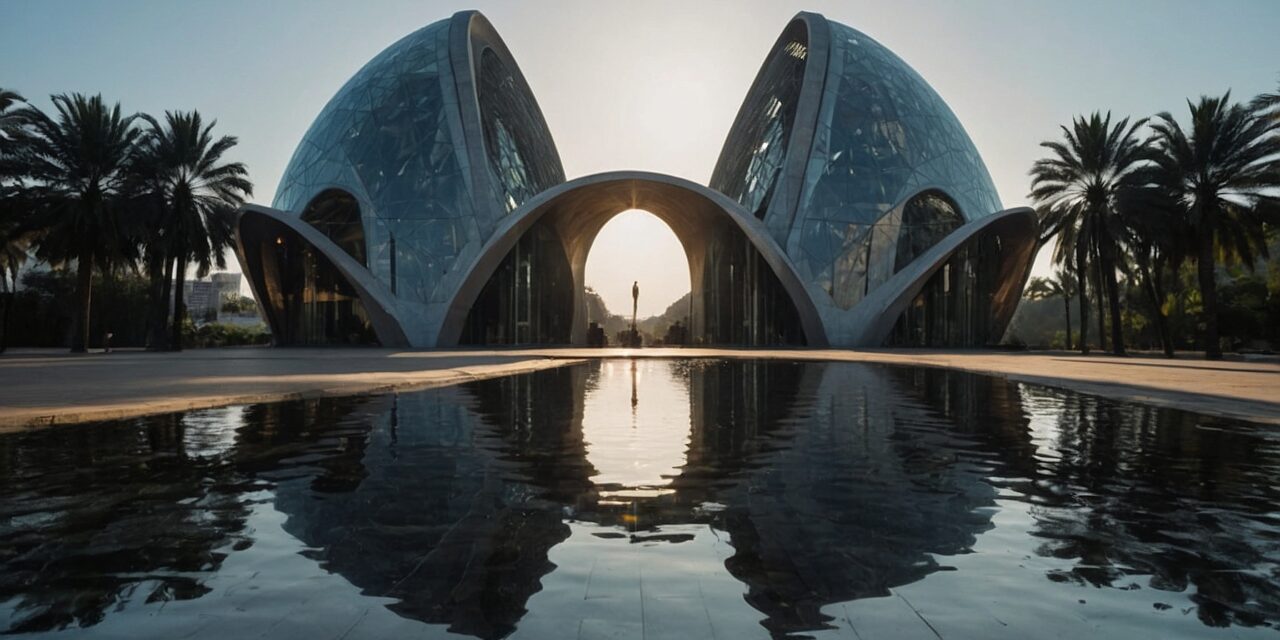Architecture is not just about constructing buildings; it is a reflection of cultural values and beliefs. Throughout history, architecture has played a crucial role in shaping societies and expressing the essence of different cultures. Understanding the relationship between architecture and culture is essential for architects, as it allows them to create spaces that resonate with the people who inhabit them. Moreover, this understanding is vital for society as a whole, as it helps us appreciate the diversity and richness of different cultures.
Architecture serves as a visual representation of a society’s cultural values. It embodies the ideals, traditions, and aspirations of a community. Whether it is the grandeur of ancient temples or the sleek lines of modern skyscrapers, each architectural style tells a story about the culture that produced it. By studying architecture, we can gain insights into the values and beliefs that shape a society’s identity.
Key Takeaways
- Architecture is a reflection of cultural values and beliefs.
- Historical context plays a significant role in shaping architectural styles.
- Traditional architecture showcases cultural values through design and materials.
- Modern architecture reflects contemporary cultural values and priorities.
- Architecture varies across different cultures and can be influenced by religion, politics, social norms, and economics.
Historical Context: How Architecture Has Evolved Over Time
Architecture has evolved significantly over time, reflecting the changing cultural values and technological advancements of each era. From the ancient civilizations of Egypt and Mesopotamia to the Renaissance in Europe and the modernist movement of the 20th century, architectural styles have continuously transformed.
In ancient times, architecture was closely tied to religious beliefs and rituals. Temples and pyramids were constructed as sacred spaces to honor deities and facilitate spiritual practices. The architectural styles of these structures were influenced by the cosmology and mythology of the respective cultures.
As societies progressed, architectural styles became more diverse and complex. The Renaissance period in Europe saw a revival of classical Greek and Roman architecture, emphasizing symmetry, proportion, and harmony. This reflected a renewed interest in humanism and the pursuit of knowledge.
Traditional Architecture: Examples of Buildings That Reflect Cultural Values
Traditional architecture provides us with a glimpse into the cultural values and beliefs of different societies. From the intricate wooden temples of Japan to the vibrant palaces of India, traditional architecture showcases the unique identity of each culture.
In Japan, traditional architecture is characterized by simplicity, harmony with nature, and a deep respect for tradition. The design of Japanese temples and shrines often incorporates natural materials such as wood and stone, blending seamlessly with the surrounding landscape. This reflects the Japanese philosophy of “wabi-sabi,” which embraces imperfection and transience.
Similarly, the palaces and forts of India reflect the country’s rich history and diverse cultural heritage. The intricate carvings, vibrant colors, and grandeur of these structures symbolize the opulence and spirituality that are deeply ingrained in Indian culture.
Modern Architecture: How Contemporary Buildings Reflect Cultural Values
Modern architecture has departed from traditional styles, embracing new materials, technologies, and design principles. Contemporary buildings around the world reflect the cultural values and aspirations of their respective societies.
In Dubai, for example, the Burj Khalifa stands as a testament to the city’s ambition and desire for modernity. As the tallest building in the world, it represents Dubai’s rapid economic growth and its aspiration to be a global hub for business and tourism.
In contrast, the Guggenheim Museum in Bilbao, Spain, designed by Frank Gehry, showcases a different aspect of cultural values. Its unconventional design challenges traditional notions of architecture and celebrates creativity and innovation. The museum has become an iconic symbol of Bilbao’s transformation from an industrial city to a cultural destination.
Regional Differences: How Architecture Varies Across Different Cultures
Architecture varies significantly across different regions due to factors such as climate, available resources, and cultural traditions. These regional differences reflect the unique cultural values and beliefs of each community.
In Scandinavia, for instance, traditional architecture is characterized by steep roofs and large windows to maximize natural light during long winters. The use of wood as a primary building material reflects the region’s abundant forests and sustainable practices.
In the Middle East, architecture often incorporates elements such as courtyards, wind towers, and intricate geometric patterns. These design features are influenced by the hot desert climate and the need for natural ventilation and shade.
Religious Architecture: How Religious Beliefs Influence Building Design
Religious architecture is a powerful expression of faith and spirituality. It reflects the religious beliefs, rituals, and traditions of a community, creating sacred spaces that inspire awe and reverence.
The Gothic cathedrals of Europe, with their soaring spires and intricate stained glass windows, are a testament to the Christian faith. These architectural marvels were designed to evoke a sense of transcendence and to connect worshippers with the divine.
In Islamic architecture, mosques serve as places of worship and community gathering. The design of mosques often includes features such as domes, minarets, and prayer halls oriented towards Mecca. These architectural elements reflect the principles of Islamic art and the importance of unity in prayer.
Political Architecture: How Buildings Reflect Political Ideologies
Architecture has long been used as a tool to convey political ideologies and assert power. From grand palaces to monumental government buildings, political architecture reflects the values and aspirations of those in power.
The Palace of Versailles in France is a prime example of political architecture. Built by Louis XIV, it was designed to showcase the absolute power of the French monarchy. The grandeur of its architecture and gardens served as a symbol of royal authority and opulence.
Similarly, the Capitol Building in Washington D.C., with its neoclassical design, represents the ideals of democracy and freedom. Its architecture draws inspiration from ancient Greek and Roman civilizations, symbolizing the democratic principles upon which the United States was founded.
Social Architecture: How Buildings Reflect Social Values and Norms
Architecture not only reflects cultural values but also social values and norms. Buildings shape our daily lives and influence our interactions with others. The design of public spaces, housing, and community centers can either foster inclusivity and social cohesion or perpetuate social inequalities.
In the Netherlands, for example, the concept of “woonerf” or living streets has been embraced to create pedestrian-friendly neighborhoods. These shared spaces prioritize the needs of pedestrians and cyclists over cars, promoting social interaction and a sense of community.
In contrast, the design of gated communities in many parts of the world reflects a desire for exclusivity and separation. These communities often prioritize security and privacy over social interaction, leading to a fragmented society.
Economic Architecture: How Buildings Reflect Economic Priorities
Economic priorities play a significant role in shaping architectural design. Buildings that reflect economic prosperity often showcase innovation, efficiency, and a focus on maximizing returns on investment.
Skyscrapers in financial centers such as New York City and London are prime examples of economic architecture. These towering structures symbolize the power and wealth of global financial institutions. Their design incorporates advanced engineering techniques to create efficient use of space and accommodate large numbers of people.
In contrast, buildings in economically disadvantaged areas may lack investment and maintenance. This can result in dilapidated infrastructure and inadequate living conditions, reflecting the economic challenges faced by these communities.
Sustainability and Architecture: How Buildings Reflect Environmental Values
In recent years, there has been a growing emphasis on sustainable architecture that minimizes environmental impact and promotes energy efficiency. Buildings that incorporate sustainable design principles reflect a society’s commitment to environmental values.
The BedZED development in London is an example of sustainable architecture. It incorporates features such as solar panels, rainwater harvesting systems, and natural ventilation to reduce energy consumption and carbon emissions. The design prioritizes the well-being of residents while minimizing the project’s ecological footprint.
Similarly, the Bosco Verticale in Milan, Italy, showcases the integration of nature into urban environments. This residential complex features vertical gardens on its façade, providing green spaces and improving air quality in the city.
The Importance of Understanding the Relationship Between Architecture and Culture
The relationship between architecture and culture is a complex and multifaceted one. Architecture serves as a reflection of cultural values, beliefs, and aspirations. By understanding this relationship, architects can create spaces that resonate with the people who inhabit them, fostering a sense of identity and belonging.
Moreover, understanding the relationship between architecture and culture is crucial for society as a whole. It allows us to appreciate the diversity and richness of different cultures, promoting tolerance and understanding. By studying architectural styles from different eras and regions, we can gain insights into the historical, social, economic, and environmental factors that shape our built environment.
In conclusion, architecture is not just about constructing buildings; it is a powerful expression of culture. It shapes our physical surroundings and influences our daily lives. By recognizing the significance of architecture in reflecting cultural values, we can create spaces that celebrate diversity, promote inclusivity, and inspire future generations.
FAQs
What is the significance of architecture in reflecting cultural values?
Architecture is a reflection of cultural values as it embodies the beliefs, traditions, and customs of a society. It is a manifestation of the cultural identity of a community and serves as a visual representation of its history, social structure, and aspirations.
How do buildings reflect cultural values?
Buildings reflect cultural values through their design, materials, and construction techniques. The use of specific architectural styles, motifs, and symbols can convey cultural meanings and values. For example, the use of domes and minarets in Islamic architecture reflects the importance of religion in Muslim culture.
What are some examples of buildings that reflect cultural values?
There are many examples of buildings that reflect cultural values, such as the Taj Mahal in India, which reflects the Mughal Empire’s love for beauty and symmetry. The Great Wall of China reflects the Chinese culture’s emphasis on defense and protection. The Sydney Opera House in Australia reflects the country’s love for the arts and creativity.
How does architecture change over time?
Architecture changes over time as societies evolve and adapt to new technologies, materials, and social structures. New architectural styles emerge, and old ones become obsolete. For example, the Gothic style of architecture emerged in the 12th century and was replaced by the Renaissance style in the 15th century.
What is the role of architects in reflecting cultural values?
Architects play a crucial role in reflecting cultural values as they are responsible for designing buildings that embody the beliefs, traditions, and customs of a society. They must be sensitive to the cultural context of their projects and work closely with local communities to ensure that their designs reflect their values and aspirations.





